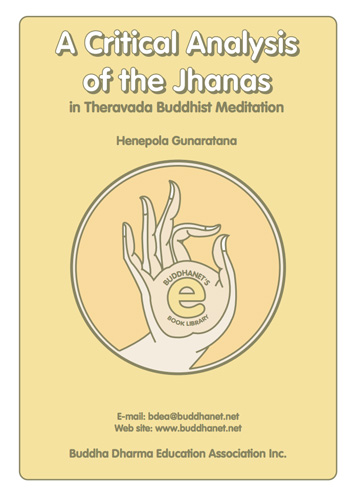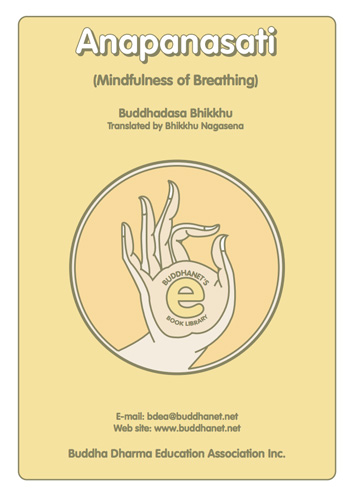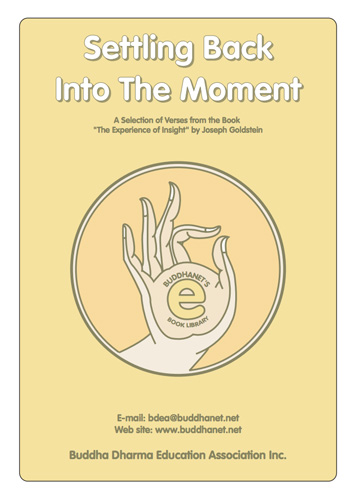 Last additions Last additions |

scrnguna.pdfA Critical Analysis of the Jhanas in Theravada Meditation4850 viewsThis work, by Ven. Henepola Gunaratana, provides an analytical study of the Jhanas, as they are an important set of meditative attainments in the contemplative discipline of Theravada Buddhism. Despite their frequent appearance in the texts, the exact role of the Jhanas in the Buddhist path has not been settled with unanimity by Theravada scholars, who are still divided over the question as to whether they are necessary for attaining Nibbana.Jan 01, 1970
|
|

anapanasati.pdfAnapanasati - Mindfulness of Breathing12183 viewsFor the first time in the English language a comprehensive manual of Buddhist meditation known as anapanasati (the development of mindfulness of breathing) is available. Although this manual is primarily intended for the benefit of monks, it will greatly assist laymen, too, who wish to undertake a course of meditation but who do not have the guidance of a teacher. Originally published in Thai, this manual is one of the major works of the Ven. Buddhadsa Bhikkhu and delivered in 1959 in the form of a series of lectures to monks of Suanmokkha Monastery, Chaiya, Thailand. Ven. Buddhadasa Bhikkhu, a major voice in the Buddhist world, is an accepted master of Buddhist meditation. In constructive positive language, the manual guides the meditator through the 16 steps of anapanasati.Jan 01, 1970
|
|

fourelements.pdfMindfulness of Breathing and the Four Elements Meditation5495 viewsVen. Pa-Auk Sayadaw
This book contains the instructions for mindfulness-of-breathing meditation, the four-elements meditation, and the subsequent detailed discernment of materiality. The last section of this book covers some of the relevant theory. Several pages have been added by the Sayadaw covering the balancing of the five controlling faculties and seven factors of enlightenment. There is also the addition of his explanation of the difference between the experience of Nibbana and the experience of life.Jan 01, 1970
|
|

nibbana1.pdfThe Practice which Leads to Nibbana2928 viewsVen. Pa-Auk Sayadaw
Translated by Greg Kleiman. This is the method of practising meditation that is taught at Pa Auk Tawya Monastery, (Myanmar) Burma. It is based on the explanation of meditation found in the Visuddhimagga commentary. Because of that the method involves several stages of practice which are complex, and involved. These stages include a detailed analysis of both mentality and matter, according to all the categories enumerated in the Abhidhamma, and the further use of this understanding to discern the process of Dependent Origination as it occurs in the Past, Present, and Future. Therefore people who are unfamiliar with the Visuddhimagga and the Abhidhamma will have difficulty in understanding and developing a clear picture of the practice of meditation at Pa Auk Tawya. For foreigners who cannot speak Burmese this problem is made even more difficult. This introduction has been written to help alleviate these difficulties by presenting a simplified example of a successful meditator's path of progress as he develops his meditation at Pa Auk Tawya.Jan 01, 1970
|
|

know-see.pdfKnowing and Seeing3744 viewsVen. Pa-Auk Sayadaw
Talks and Questions and Answers at a meditation retreat in Taiwan by Venerable Pa-Auk Sayadaw. This book details two approaches to insight meditation, namely, tranquility and insight and bare-insight meditation. These two methods are essentially identical, starting from four-elements meditation and continuing into insight meditation. In this book the reader has an explanation of the classic instructions for both methods. The talks in this book were given by the Sayadaw (teacher), from Pa-Auk, Mawlamyine, Myanmar, while he conducted a two-month meditation retreat at Yi-Tung Temple, Sing Choo City, Taiwan.Jan 01, 1970
|
|

settleback.pdfSettling Back Into The Moment3614 viewsA selection of verses from the book 'Experience of Insight' , by Joseph Goldstein. This book belongs to a different genre, not a book in the sense of having a beginning and an end. It is a compilation of excerpts that stand alone in meaning whichever way your finger may flip open the page. Readers are strongly encouraged to read Joseph Goldstein's Experience of Insight - a simple and direct guide to Buddhist Meditation (Published by Shambala Publications, Inc.) from whose book this compilation is attributed.Jan 01, 1970
|
|

seeding.pdfSeeding the Heart3079 viewsGregory Kramer
Loving-kindness Meditation with Children. The practice of loving-kindness, or metta, can be done in one of two ways: either in intensive prolonged meditation to develop deep states of concentration, or in daily life at any time one meets with people and animals or thinks about them. To learn about the radiating of metta to all beings with children, we have to tap into the store of knowledge accumulated by lay people and parents. It must be knowledge which has grown out of years of living and loving with children and young adults. Gregory Kramer, father of three boys, shows us here with what subtle but precise adjustments in the standard practice of loving-kindness he was able to anchor it in the lives of his children.Jan 01, 1970
|
|

med-guided2.pdfGuided Meditation for Primary Students4304 viewsBuddhaNet's Buddhist Studies for Schools
This is a series of guided meditations with instruction for teachers for primary students. This file is part of BuddhaNet's Buddhist Studies for Schools. It has seven guided meditations for students, with detailed instructions for teachers.Jan 01, 1970
|
|

scrn_metta.pdfMetta Bhavana; Loving-kindness; Meditation3634 viewsVen. Dhammarakkhita
This is short explanation on how to practise Metta Bhavana or Loving-kindness Meditation given as a three-day weekend retreat at Dhammodaya Meditation Centre in Nakhon Pathom in Thailand, by an Australian monk, Ven. Dhammarakkhita (Jeff Oliver).Jan 01, 1970
|
|

hello_with_love.pdfHello - with Love & Other Meditations3286 viewsMaster Visuddhacara
The three most important things in life are love, kindness and wisdom. If we have made these three values the priorities of our life, then our life will have been well-lived. When we die we can only have happiness when we look back and not regrets. Wealth, fame, power, status, worldly success and pleasures - these are insignificant compared to love, kindness and wisdom. Cultivate the latter. If we spend our life cultivating this trio, our birth and life will have been worthwhile; it will not have been in vain. In this booklet, Ven. Visuddhacara shares his understanding of this practice of mindfulness and loving-kindness with a view to encourage all of us to walk the path.Jan 01, 1970
|
|
| 1212 files on 122 page(s) |
 |
 |
 |
116 |  |
 |
 |
|
